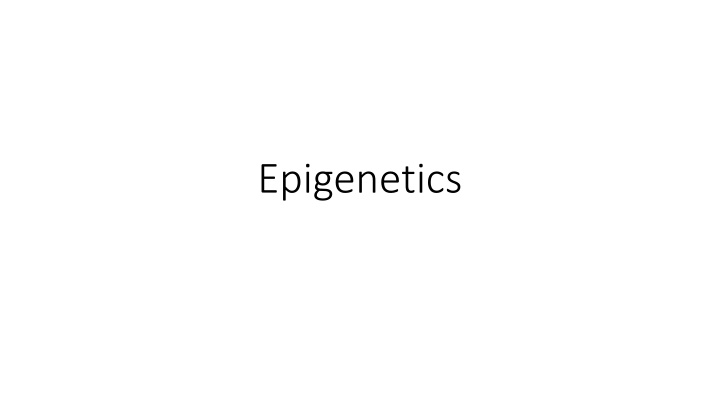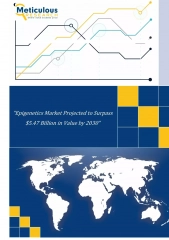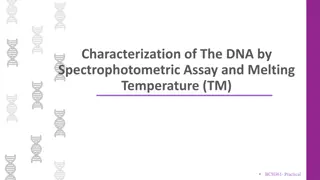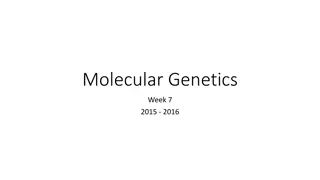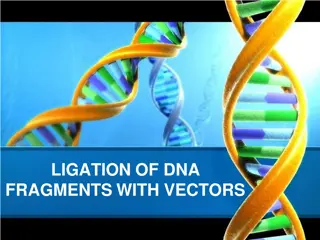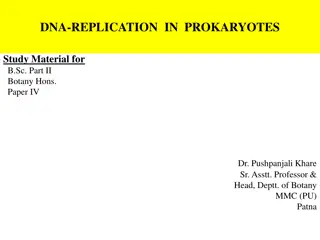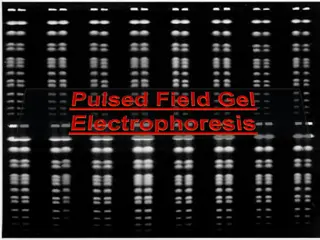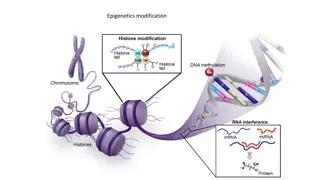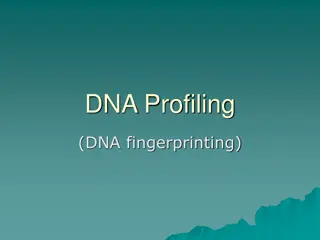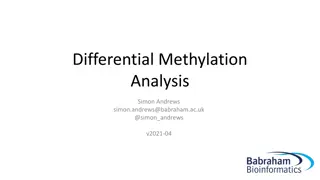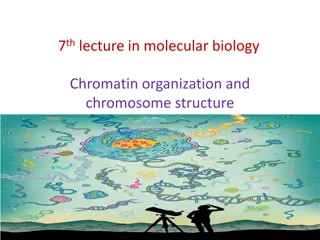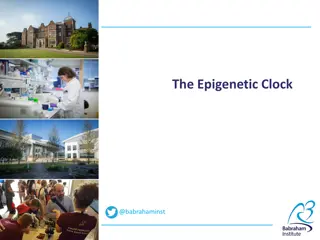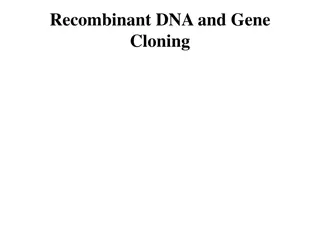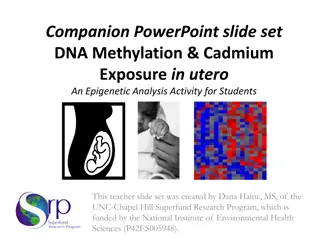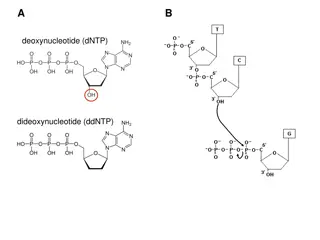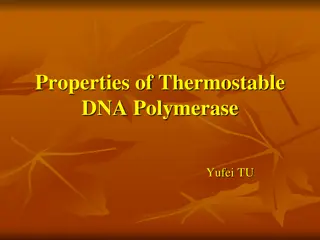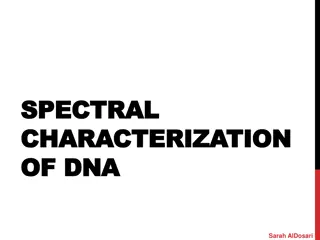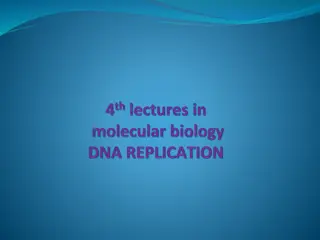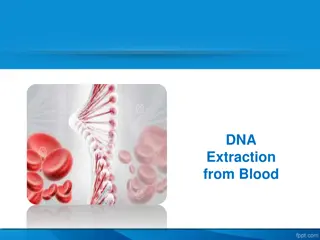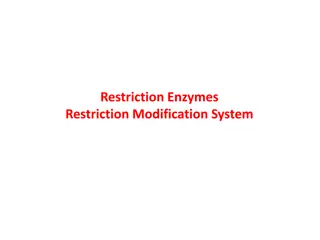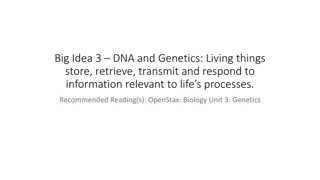Epigenetics: DNA Methylation and Histone Modification
Epigenetics involves modifications that impact gene expression without altering DNA sequences, playing a crucial role in the transition from genotype to phenotype. This includes DNA methylation, histone modification, and microRNAs. DNA methylation, controlled by DNMT enzymes, can lead to either gene activation (hypomethylation) or inactivation (hypermethylation). Histone modifications, such as acetylation and deacetylation, influence chromatin structure and gene expression. These epigenetic processes are essential for regulating various cellular functions.
Download Presentation

Please find below an Image/Link to download the presentation.
The content on the website is provided AS IS for your information and personal use only. It may not be sold, licensed, or shared on other websites without obtaining consent from the author.If you encounter any issues during the download, it is possible that the publisher has removed the file from their server.
You are allowed to download the files provided on this website for personal or commercial use, subject to the condition that they are used lawfully. All files are the property of their respective owners.
The content on the website is provided AS IS for your information and personal use only. It may not be sold, licensed, or shared on other websites without obtaining consent from the author.
E N D
Presentation Transcript
Epigenetics modification: Changing in gene expression without affecting the primary DNA sequence. So, epigenetic modifications regulate the processes during the transition from genotype to phenotype. Epigenetic modification including DNA methylation, histone modification and micro RNAs.
DNA methylation DNA methylation is an epigenetic modification that occurs as a result of a biological mechanism that leads to the attachment of a methyl group onto the 5thcarbon of cytosine (5mC). DNA methylation processes are controlled by the DNA methyltransferase enzyme (DNMTs) family, which create 5 methylcytosine (5mC) via transferring a methyl group from a donor S- adenosyl methionine (SAM) to the 5th carbon of cytosine. DNA according to methylation status is either Hypomethylated or hypermethylated. A: CH3 is added to cytosine in the presence of DNMT enzymes and SAM (donor). B: Symmetrical CpG methylation. C: Diagram shows relation between DNA methylation and gene expression.
Hypomethylation is a process that leads to gene activation (oncogenes) and is carried out by two mechanisms. Passive process: loss or reduction of DNMT enzyme during cell division. Active process: ten-eleven translocation (TET) enzyme via an enhanced oxidation mechanism leads to convert methylated cytosine to unmethylated cytosine. Hypermethylated is a process that leads to gene inactivation (Tumor suppressor genes). which suggested an increase of DNMTs enzymes activity in cancer cells compared to normal cells.
image DNA methylation controlling gene expression. (A) The CpG island promoter is unmethylated and allows binding of transcription factors, which is required for transcription initiation. (B) The CpG island promoter methylation deters binding of transcription factors and causing gene inactivation.
Histone modification: Histone proteins (H2A, H2B, H3 and H4) have N- and C- terminals that form histone tails, where post-translation modifications often take place causing changes of chromatin structure, including phosphorylation, methylation, and acetylation. Histone acetylation: Histone acetyl transferase (HAT): tend to add acetyl group on lysine residue on histone tail, which leads to chromatin becoming permissive and as a consequence a transcription process takes place. Histone deacetylase (HDAC): tend to remove an acetyl group, causing stability of chromatin structure and expression inhibition.
Acetyl group remove + charge Decrease interaction between histone and negatively charged DNA packed chromatin converts to unpacked chromatin Increase Gene expression
Histone methylation: Histone methylation takes place on lysine or arginine residues, and is regulated by: Histone methyltransferases that transfer methyl groups from SAM to amino groups or guanidino group of lysine or arginine respectively. Histone methyltransferases by removing a methyl group. demethylases, which function antagonistically to histone
MicroRNAs: MicroRNAs (miRNAs), belong to a non-coding RNA family and consist of 17-25 nucleotides. miRNAs epigenetically contribute in governing gene expression in various pathways, for instance miRNA expression may be controlled by epigenetic mechanisms, miRNAs are involved in inhibition of some epigenetic elements, or cooperation between miRNA and epigenetic elements is required to achieve a specific task. In addition, some of 50% miRNAs, that are placed in CpG islands, have been regulated by DNA methylation and they were abnormally expressed in different tumours including miR-31 (breast cancer) and miR-124a (colon cancer).
miRNAs involvtranslational repression or degradation of the target mRNA (messenger RNA). miRNAs are a class of short, non-coding, single-stranded RNA molecules, approximately 22 nucleotides in length, that negatively regulate gene expression at the post-transcriptional level. They bind sequences in the target messenger RNA through complementarity and form RNA-RNA complex.
Reference: DNA Methylation in Mammals (En Li and Yi Zhang) DNA methylation: a form of epigenetic control of gene expression ( Derek Lim and Eamonn Maher)
